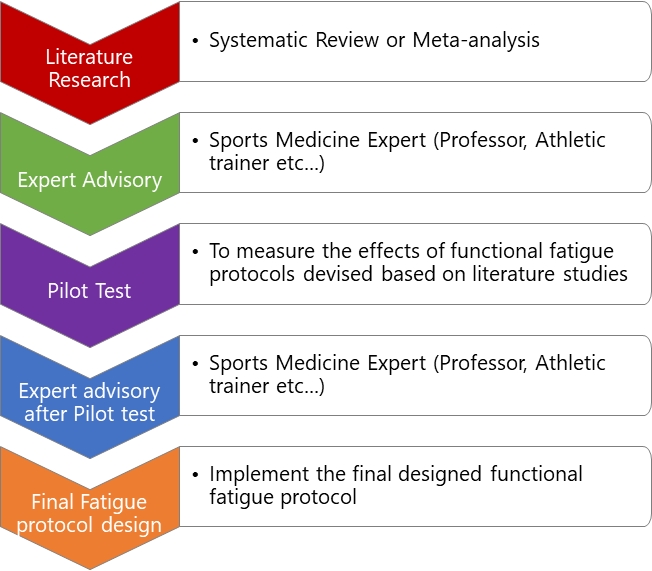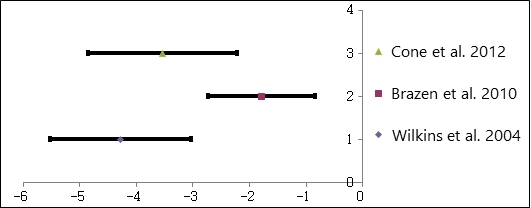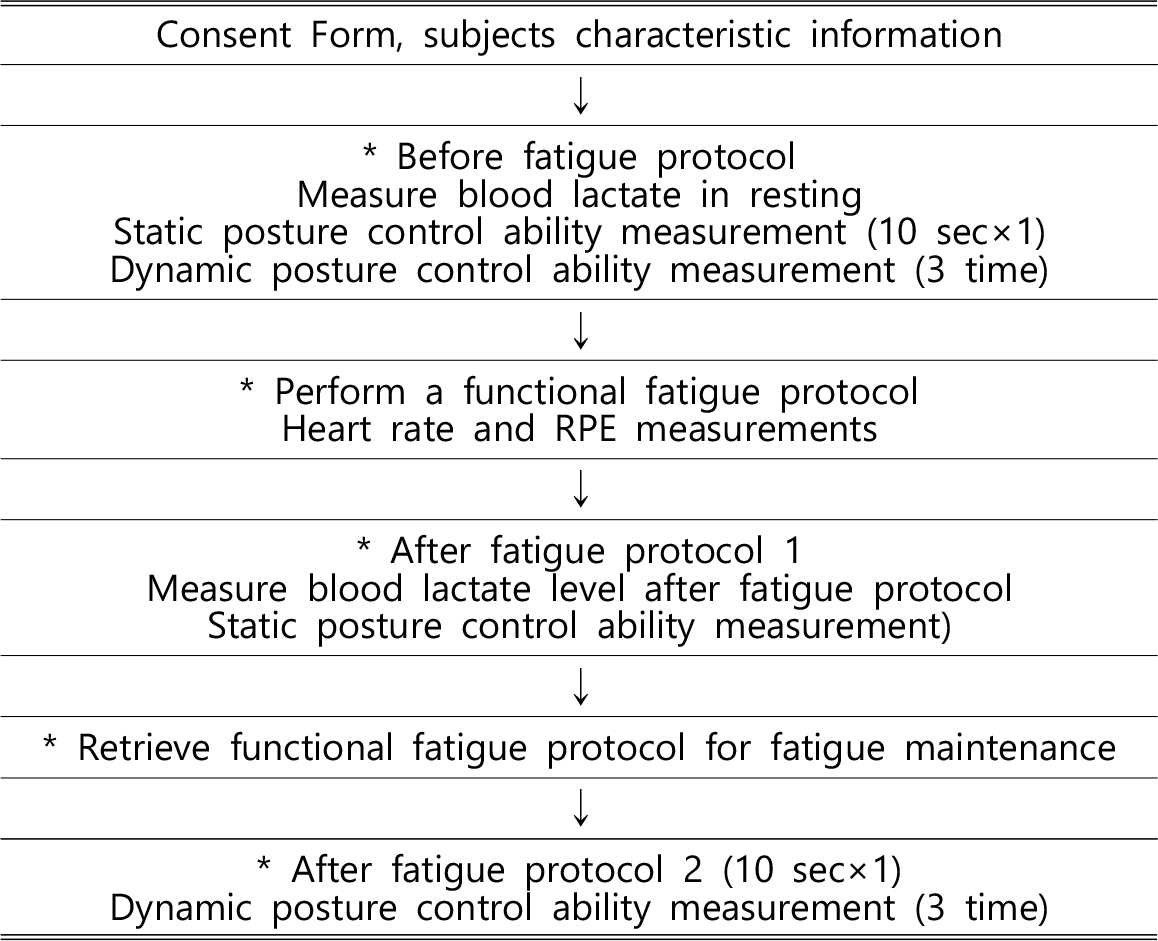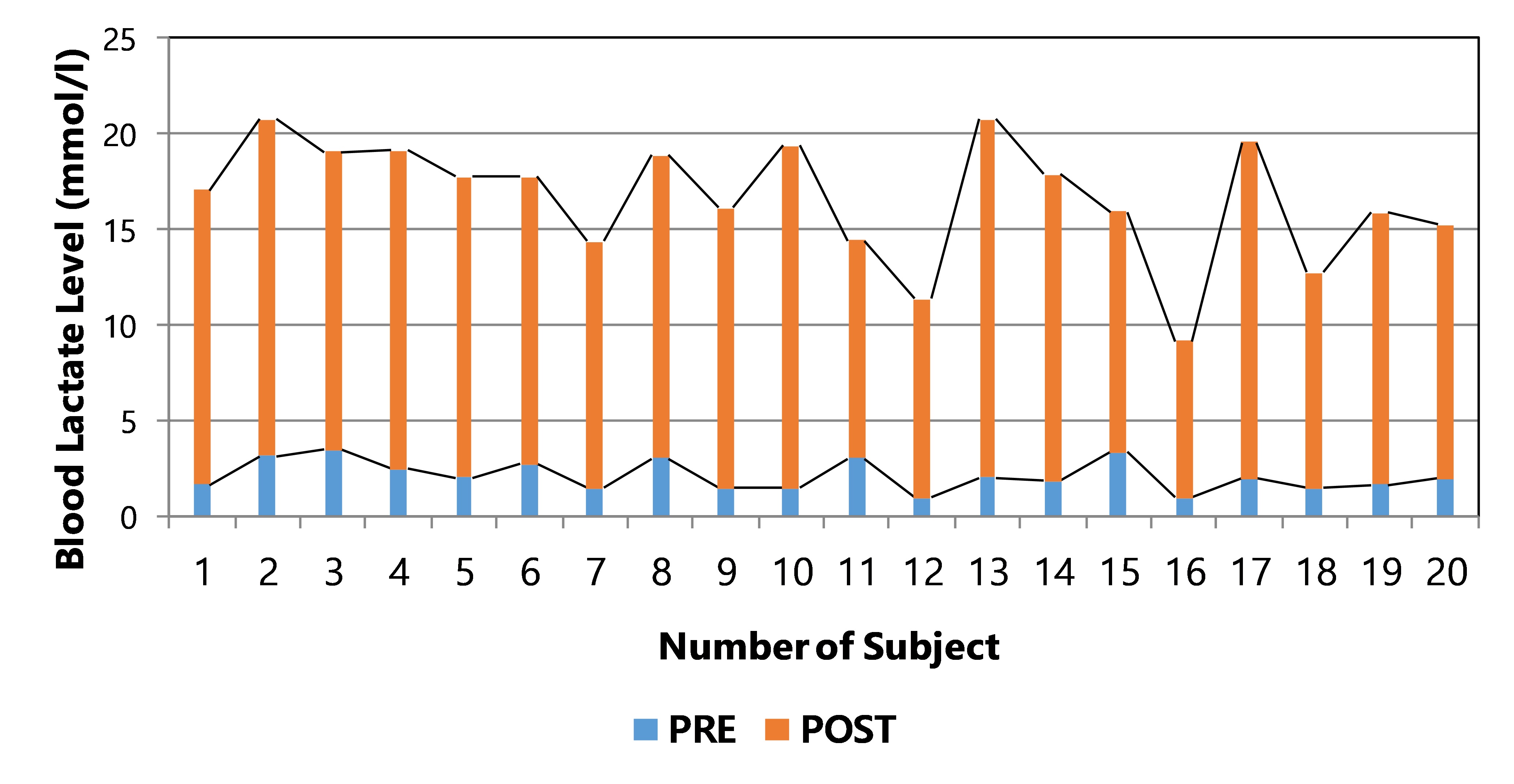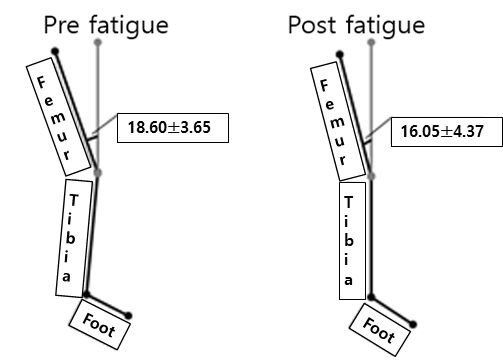기능적 피로 프로토콜이 하지의 정적·동적 자세조절 능력에 미치는 영향
Effect of functional fatigue protocol on static and dynamic postural control of lower extremities
Article information
Abstract
목적
본 연구는 기능적 피로 프로토콜이 하지의 동적 및 정적 자세조절의 기능적 움직임 특성에 미치는 영향을 살펴보는 데 있었다.
방법
총 20명의 대학생(남자 10명, 여자 10명, 나이 22.5±2.7, 체중 67.0±13.0kg, 신장 168.0±8.9cm)을 대상으로 개발된 운동 피로 프로토콜을 실시하였다. 남녀 그룹으로 나누어 기능적 피로 프로토콜 적용 전·후의 혈중 젖산 수치, 심박 수, 운동자각도 검사와 정적·동적 자세조절 검사(10초간 눈 감고 한 발로 균형 지면반력기에 서 있기, 30cm 박스 위에서 한 발로 착지하기)를 측정하여 하지의 기능적 특성 미치는 효과를 검증하였다.
결과
기능적 피로 프로토콜이 피로 전보다 피로 후에 평균 심박 수 분당 176.3과 평균 운동자각도 18을 보였고, 혈중 젖산 수치는 유의한 차이를 보였다(p<.05). 또한, 정적 자세조절에서 많은 움직임과 실패 횟수를 보였고(p<.05), 동적 자세조절에서 착지 전략이 다소 경직된 동작으로 변했다. 즉, 초기접지 시점과 최대 수직 지면 반력 시점에서 무릎 굽힘이 감소한 결과를 보였다.
결론
본 연구의 결과로 고안된 운동 피로 프로토콜은 하지의 피로를 유발할 뿐만 아니라 피로-지구력을 향상하는 훈련으로 사용할 수 있다. 향후 연구에서 착지 전략 자세를 명확하게 확인하기 위해 착지 높이를 높일 것을 권장한다.
Trans Abstract
Purpose
The purpose of this study was to investigate the effects of a functional fatigue protocol on lower extremity dynamic and static postural control.
Methods
A total of 20 physically active collegiate students participated in this study (ten males, ten females; age 22.5±2.7 years; mass 67.0±13.0 kg; height 168.0±8.9 cm). A unilateral stance with eyes closed for 10 seconds was performed to test static postural control using a balance force plate and single-leg drop landing on 30cm box was performed as a dynamic postural control test and captured using VICON motion analysis system.
Results
The results of this study showed an average heart rate of 176.3 beats/minute, an 18 rating on the perceived exertion scale, significant differences in blood lactate, and a static postural control deficit after fatigue as compared with before fatigue(p<.05). Dynamic postural control after fatigue changed landing strategy in the form of stiff landing. Knee flexion was decreased at initial contact and at peak vertical ground reaction force, also, both decreased valgus and internal rotation of knee joint.
Conclusions
This protocol may use for enhancing fatigue-endurance training as well as for inducing fatigue. Further, to ascertain a landing strategy, it is recommended to increase landing height to clearly observe changes in landing strategy.
서 론
피로는 근육의 수행 능력을 감소시키고, 자세를 불안정하게 만들며, 잠재적으로 상해 위험을 높인다(Cortes et al., 2012; Kraemer et al., 2001). 근 피로는 감각 운동기능(sensorimotor)의 상해를 초래하게 될 수 있고 이는 상해 위험을 증가시키는 위험요인이 될 수 있다(Zech et al., 2012). 이와 관련하여 Frisch et al.(2011)은 유소년 축구선수들을 한 시즌 동안 상해를 추적 조사해 본 결과, 피로가 정신적 스트레스, 상해 경험, 관절 이완 등의 다른 원인보다 상해에 미칠 가능성이 2배 이상 높다고 보고하고 있다. 축구의 상해 요인들을 살펴본 선행연구들을 보면, 비접촉 하지의 상해들은 경기 후반 마지막 15분을 전후해 발생한다는 점을 미루어 보아 피로가 상해를 일으키기 쉬운 상황으로 만드는 것은 유력한 사실이라고 할 수 있다(Hawkins & Fuller 1999; Price et al., 2004; Rahnama, Reilly & Lees, 2002). 본 연구는 “근신경계의 기능은 피로에 의해 그 기능이 저하되게 되고 이의 결과로 하지의 정적·동적 자세조절 능력에 영향을 미칠 것”이라는 연구 가설에서 출발하고 있다.
피로는 넙다리 네갈래근(quadriceps femoris muscle) 및 넙다리 뒤근육(hamstring)의 최대 회전력의 저하(Greig, 2008), 한 발 착지자세 시 초기 접지(initial contact, IC) 엉덩 관절의 굽힘각 감소와 내회전의 증가(Borotikar et al., 2008), 보행 시 저측 굴곡근과 배측 굴곡근의 불균형(Granacher et al., 2010; Tang & Woollacott, 1998), 균형감각과 동작 제어의 결함(Gribble & Hertel, 2004; Johnston et al., 1998), 신경근 제어 및 관절 고유수용감각의 기능 저하(Hassanlouei et al., 2012; Lattanzio et al., 1997; Chapman et al., 2009)와 같은 근력의 감소 및 불균형 그리고 신경조절 능력의 저하 원인이 되어서 하지 상해의 원인이 될 수 있다.
최근 연구에서는 배구나 축구와 같은 특정 스포츠에 특화된 피로 프로토콜을 제시해 훈련용 그리고 측정용으로 활용하고 있다. 이러한 특화 피로 프로토콜로 발생한 피로는 무릎관절 위치감각(knee joint position sense)의 정확도와 지속성 감소, 넙다리 뒤근육과 넙다리 네갈래근의 등속성 수축력 감소로 인하여 상해 위험이 증가할 가능성이 높음을 보고한 사례도 있다(Ribeiro et al., 2008; Small et al., 2010). 이러한 변화들은 하지의 근신경과 운동역학적 특성을 변화시켜 근-건 염좌나 골절과 같은 상해를 유발할 수 있다(Egol et al., 1998; Garrett, 1990).
근래에 들어서 운동 종목과 유사한 피로 프로토콜이 종종 연구되고 있지만, 특정 종목에 표준화된 피로 프로토콜은 존재하지 않으며, 기존에 많이 활용되는 전통적인 피로 프로토콜을 사용하는 경우가 대부분이다. 아직 스포츠 상황과 유사한 기능적인 피로 프로토콜 (functional fatigue protocol, FFP)에 대한 연구는 미비한 수준이고, 기능적 피로 프로토콜을 통한 연구라 하더라도 하지 근력이나 운동학적 요소 등의 변화(Rahnama, Lees, & Reilly, 2006; Small et al., 2009)는 보고되고 있지만, 피로를 통해 하지의 정적·동적 자세의 변화들을 포괄적으로 분석한 연구는 없는 실정이다. 그러므로 본 연구에서는 선행 연구에서 사용한 피로 프로토콜 중에서 축구 경기에서 발생할 수 있는 동작들 중심으로 재구성하여 기능적 피로 프로토콜을 만들어 훈련용, 그리고 평가용으로 활용해 보고자 한다. 그러므로 본 연구는 문헌고찰을 통하여 고안한 축구용 기능적 피로 프로토콜을 사용하여 하지의 피로 전·후에 정적·동적 자세조절 능력에 어떠한 변화가 발생하는지 확인해보고 이러한 변화가 상해에 어떠한 영향을 줄 수 있는지 분석하는 데 목적이 있다.
연구방법
연구대상
본 연구에 참여한 대상자들은 예비 실험 결과를 바탕으로 G-power 3.1.5(University of Düsseldorf, Germany)버전 프로그램을 실행해 선정하였다. 예비 실험에서 기능적 피로 프로토콜 후 변화되는 무릎관절의 외반과 내·외측 회전 값을 기초로 파워 분석을 통해 연구 대상자 수를 결정하였다. 이때 사용한 값들은 <Table 1>과 같다.
이들 값을 사용하여 α=.05, 파워 1-β=.8로 설정하여 연구 대상자 수를 분석한 결과 17명으로 나타났으며, 연구 대상자의 중도 탈락 가능성에 대비하여 연구 대상자 수를 20명으로 설정하였다<Table 2>.
설문지를 통해 최근 1년간 근골격계 상해가 없는 대상자로 선정하였고, 실험 제외 대상은 다음과 같다.
1) 최근 1년간 근골격계 상해가 있었던 사람
2) 생애 하지 수술을 받은 경험이 있는 사람
3) 정적·동적 자세조절에 영향을 미칠 신경 상해 경험이 있던 사람
측정 항목 및 절차
본 연구에서 사용된 기능적 피로 프로토콜은 <Fig. 1>과 같은 절차를 거쳐 고안되었다.
축구와 관련된 피로 프로토콜을 보고 한 연구 중 피로 전후 운동자각도(Rating of perceived exertion: RPE)값들을 추출하여 운동자각도의 증가 효과크기(effect size: ES)의 값이 0.6 이상이고, 효과크기의 95% 신뢰구간이 0을 지나지 않는 연구(Cone et al., 2012; Brazen et al., 2010; Wilkines et al., 2004)들을 살펴본 결과 세 개의 연구들이 선택되었고 <Fig. 2> 이 연구에서 사용된 피로 프로토콜을 종합하여 새로운 기능적 피로 프로토콜을 개발하였다<Fig. 3>.
기능적 피로 프로토콜의 구성은 5 m 전방질주, 5 m 사이드 스텝, 5 m 후방질주, 총 10 m 왕복 L장형 전방의 질주, 사이드 점프 20 회, 50 cm 콘 전방점프, 그리고 무릎 가슴 닿기 제자리 점프 10회의 순서로 구성된 피로 프로토콜이다. 매 바퀴마다 실험대상자들이 착용하고 있는 웨어러블형 심박 측정기를 사용하여 심박과 RPE를 측정하여 기록하였다. 기능적 피로 프로토콜을 활용한 전체적인 실험의 절차는 아래의 <Fig. 4>와 같다.
본 연구의 연구 디자인은 pre-post design으로서 피로 전·후에 혈중 젖산 수치와 정적·동적 자세조절 능력을 측정하였다. 실험 전 연구 대상자들에게 실험의 목적과 방법을 설명했다. 정적 자세조절과 피로 프로토콜을 시행할 때는 편안한 운동복을 입고, 동적 자세조절을 시행할 때는 스판덱스(spandex) 재질의 타이츠를 입고 측정하였다. 신발은 대상자가 준비한 개인 운동화를 착용하였다. 측정 도구는 <Table 3>과 같다. 동적 자세조절 능력 측정 시 하지 선정은 공을 찰 때 주로 사용하는 다리로 결정하였다.
자료 수집 및 분석
혈중 젖산
혈액을 추출하여 Lactate pro test strip에 흡인시켜 Lactate Pro™ LT-1710(ARKRAY Inc, Japan)에 삽입해 피로 전후 혈중 젖산 수치의 변화를 알아보았다.
정적 자세조절
정적 자세조절 자료들은 실험 대상자의 한발(주발)을 이용하여 눈을 감은 상태에서 10초간 유지하였을 때 Accusway 지면반력기를 사용하여 수집하였다. 각 실험대상자 당 1번 성공적으로 실시한 데이터들만 Balance Clinic(AMTI, ver 2.02.01, Watertown, MA) 분석프로그램을 이용하여 전통적인 압력 중심 분석 변인들을 추출하였으며, Matlab(ver R2010b)으로 프로그램하여 time-to-boundary(TTB) 변인들을 추출하였다. TTB는 압력중심이 얼마나 빠른 시간에 발의 M-L 또는 A-P의 경계에 도달하는지를 측정하는 변인으로서 그 값이 작으면 경계에 도달하는 속도가 빠름을 의미해 균형능력의 결손을 판단할 수 있는 변인이다. 이들 변인의 추출은 Knapp et al.(2011)의 연구에서 제시한 방법을 사용하였다. 추출하고 분석된 변인들의 목록과 설명은 <Table 4>와 같다.
동적 자세조절
7대의 적외선 카메라(Vicon MX-F20, Oxford Metrics Ltd, Oxford, UK)로 구성된 동작 분석 시스템을 사용하여 30 cm 높이의 발판 위에서 외발(주발) 착지 시 동적 자세조절의 운동학적 자료를 수집하였다. 마커 셋(marker set)은 Plug-In Gait marker set에 16개의 마커를 추가해 총 32개의 마커를 몸에 부착하였으며, 마커 부착 위치는 <Fig. 5>와 같다. VICON Nexus를 통해 촬영된 마커를 라벨링(labeling) 하였으며, 데이터 추출은 자체 제작한 데이터 처리 프로그램(LabVIEW 8.5, National Instrument Inc, Austin, TX, USA)으로 동적 자세조절의 운동학적 변인을 추출하였다.
동적 자세조절 능력을 알아보기 위해 엉덩이, 무릎, 발목관절에서의 3차원 운동학적 및 운동역학적 변인들을 추출하여 분석하였다. 또한, 운동학적, 운동역학적 변인의 최대 및 최솟값, 초기접지, 최대 수직 지면 반력 발생 시, 무릎관절 30 굽힘 시, 무릎관절 최소 굽힘각 시 각 값 등을 추출하여 분석하였다.
통계 처리
본 연구의 통계는 IBM SPSS 21 ver.로 처리하였다. 기능적 피로 프로토콜 전·후 혈중 젖산 농도와 하지의 동적 자세조절은 paired t-test를 사용했으며, 기능적 피로 프로토콜을 수행하는 동안 측정한 심박 수와 RPE는 평균±표준편차로 비교하고, 정적·동적 자세 조절은 효과크기를 통해 차이의 크기를 분석하였다. 유의수준은 α>.05 수준에서 검증하였다. 결과에서는 정적 자세조절 능력 변인에서는 모든 변인들의 값을 보고하고 동적 자세조절 능력에서는 통계적으로 유의한 차이가 있고 효과크기가 .6 이상을 보인 변인들만을 보고하고 논의 하였다. Cohen의 효과크기의 기준에 의해 효과크기 .6이상(큰 차이)이고 통계적으로 유의한 차이가 있는 경우 의미 있는 결과로 해석하여 논의하였다.
결 과
혈중 젖산 수치, 심박수와 운동자각도
기능적 피로 프로토콜 수행 전후 혈중 젖산 수치 변화는 <Fig. 6>과 같으며, 피로 후 젖산 수치는 증가하는 것으로 났다(p<.05). 또한, 기능적 피로 프로토콜 수행 중 측정한 평균 심박수와 평균 운동자각도는 각각 176.25±18.22 beats/min, 18.14±0.91로 높게 나타났다.
정적 자세조절 능력
정적 자세조절 능력의 변인은 <Table 5>와 같다. 8개 변인에서 유의한 차이를 보였다(p<.05), 효과크기가 0.6 이상이고 통계적으로 유의한 차이를 나타낸 변인은 총 4개로 나타났다. 또한, 피로 후 한 발로 10초 동안 서 있지 못하고 실패한 횟수가 피로 전 1.10±1.51회에서 3.35±4.99 회로 피로 후 유의하게 증가했다(p<.05).
논 의
스포츠 경기 후반 마지막 15분 전후에 부상이 많아진다는 점에서 실마리를 얻어 하지의 부상에 피로가 어떠한 영향을 미치는지 알아보고자 본 연구를 진행하였다. 본 연구의 주된 발견 사항을 정리해 보면 다음과 같다. 첫째, 정적 자세조절 능력을 검사해본 COP 및 TTB 관련 변인에서는 A-P 방향의 자세조절 능력(SD COP, A-P 방향의 COP Range, A-P 방향 % Range used, 그리고 Area 95%)에서 결손이 나타났다. 둘째, 한 발로 10초 동안 서 있지 못한 실패 횟수가 피로 전보다 피로 후 증가했다. 셋째, 외발 착지 시 동적 자세조절에서는 피로 후 시상면에서의 동작들에서 경직된(stiff) 착지 형태를 띠는 것으로 나타났다.
본 연구에서는 선행 연구(Cone et al., 2012; Brazen et al., 2010; Wilkines et al., 2004)들과 달리 선행연구에서 사용한 피로 프로토콜의 효과를 검증해 본 후 기능적인 피로 프로토콜로 재구성해 개발하였다. 한 피로의 정도를 간접적으로 추정할 수 있는 젖산 농도, 심박 수, 및 운동 자각도 등을 직접 측정함으로써 본 연구에서 개발한 기능적 피로 프로토콜의 피로 여부와 강도를 제시하였다. 혈중 젖산 농도는 큰 폭으로 증가하였으며, 평균 나이 22 세 연구 대상자들의 최대 심박 수를 약 90 %까지 올리고, 매우 강한 수준(very hard)인 RPE 18 전·후의 고강도 운동으로 대상자들의 피로가 발생했음을 확인할 수 있었다.
정적 자세조절 능력을 측정한 변인으로 압력 중심의 속도와 TTB 관련 변인(Center Of Pressure excursion velocity, COPV)들를 측정해본 선행 연구에서는(Hoch, & McKeon, 2011; McKeon & Hertel, 2007: Gribble, Tucker, & White, 2007; Zech et al., 2012) 피로 후 M-L 방향의 자세조절 능력에서의 결손이 나타났음을 보고하고 있다. 그러나 본 연구에서는 피로 후 M-L 방향이 아닌 A-P 방향에서 자세조절 능력의 결손이 나타났다. 이는 본 연구에서 사용한 축구에 특성화된 기능적 피로 프로토콜로 인하여 자세를 조절 전략이 변했음을 시사하는 결과라 볼 수 있다. 즉, 피로 프로토콜의 형태나 종류에 따라 다른 결과를 나타내는 것으로 보인다. 이전 연구에서는 로컬 근육(발의 내·외번근)의 반복적인 수축을 발생시켜 피로를 유발했지만, 본 연구에서는 전체적으로 시상면에서의 반복적인 동작과 점프를 통해 피로를 유발한 프로토콜의 차이가 있음을 주지해야 할 것이다.
A-P 방향 자세 조절의 어려움은 적절한 시상면상의 동작조절 어려움으로 인한 것으로 하지 상해의 원인이 될 수 있다. 동적인 동작에서 정상과 다른 부적절한 무릎관절의 굽힘각의 원인이 될 수 있음을 시사하며 본 연구의 무릎관절 시상면 동작의 관절경도 증가의 원인일 수 있다. 무릎관절의 관절경도의 증가는 하지의 특히 무릎의 전방십자인대 상해의 주된 원인이 됨을 주시해야 할 것이다(Kulas et al., 2010; Laughlin et al., 2011; Shimokochi et al., 2011).
동적 자세조절 능력을 측정한 결과에서는 피로 후 30cm 착지 시점에서 시상면 동작인 굽힘각이 작게 나타났는데 이 시점은 pre-activation의 효과를 관찰할 수 있는 시점이다(Iida et al., 2011). 피로 이후 하지의 안정성을 높이기 위해 전략적으로 무릎을 고정하고 관절경도를 증가시킨 결과라고 할 수 있다<Fig. 7>. 이러한 결과로 근육의 활성 수준이나 넙다리네갈래근 위주의 충격 흡수기전이 발생하게 되어 정강뼈의 전방전위를 유발하게 된다. Meyer & Haut(2008)의 연구에서는 작은 무릎각도에서 발생하는 넙다리뼈와 정강뼈 사이의 압축력(compressive force)은 넙다리뼈를 후방으로 이동하게 하므로 전방십자인대의 상해를 유발하는 기전이라고 보고하고 있다. 이는 근위 정강뼈의 후방경사에 의해서 발생하는 현상으로 전방십자인대의 장력을 증가시키는 원인이 되므로 상해의 예방 측면에서 주의해야 할 동작이다.
경직된 착지자세는 최대 수직 지면반력(Peak vertical ground reaction force; PVGRF) 시점에서도 발견할 수 있다(Fig. 8). PVGRF 시점에서도 피로 전보다 피로 후 무릎의 굽힘이 감소하였고, 이는 선행 연구(Cortes et al., 2012; Lucci et al., 2011; Quammen et al., 2012)에서 기능적 피로 후 side cutting이나 stop-jump 동작 시 PVGRF 시점의 무릎 굽힘이 감소하는 현상과 유사하다고 볼 수 있다. 전방십자인대 부상의 주된 원인으로 꼽히는 경골의 전방전위(tibia anterior translation)가 최대로 나타나는 시점은 무릎 굽힘 각도가 20-30° 전후로 굽혀질 때임(Dai et al., 2012; Berns et al., 1992)을 인지하였을 때, PVGRF시점에서의 감소된 무릎 굽힘각도(29.82°)는 정강뼈의 전방전위를 유발하며 PVGRF의 증가로 넙다리뼈와 정강뼈 사이의 압축력은 정강뼈의 전방전위를 증폭시키게 된다. 이와 동시에 피로 후 무릎 및 발목 굽힘각의 감소로 하지 전체의 경도가 증가한 상태로 접지하게 되므로 하지 상해의 가능성을 증가시키는 원인이 된다.
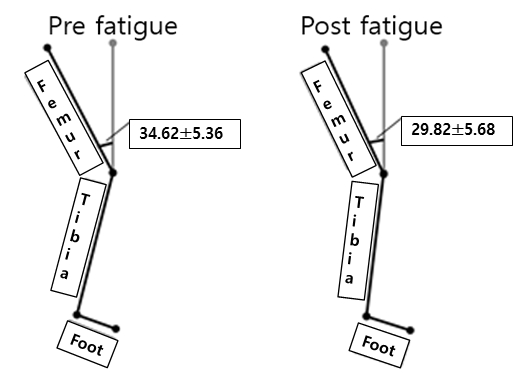
Knee flexion angle before and after functional fatigue protocol at maximum vertical ground reaction force
본 연구에서는 근육이 피로한 상태가 되면 초기접지 시 시상면에서의 자세와 전반적인 착지 전략에 영향을 미친다는 것을 알 수 있었다. 일반적으로 선수들의 상해를 예방하기 위한 전략으로 자세조절 능력 훈련을 실시하게 되는 경우가 빈번하다. 본 연구의 결과물을 적용하게 된다면 자세조절 능력 훈련은 근육의 피로가 발생한 시점에서도 실시할 필요가 있을 것이다. 일반적으로 축구 훈련 시 효과적인 자세조절을 위한 근신경조절 운동(neuromuscular training exercise)은 훈련 전 준비 운동의 성격으로 많이 이루어지는 경우가 많으나 훈련이 종료된 마무리 운동에서는 시행하지 않는 경우가 있다. 본 연구의 결과를 토대로 하지의 정적·동적 자세조절 능력의 증강을 위한 목적으로는 훈련 전후 준비 운동 및 마무리 운동으로 근신경조절 운동을 시행하는 것이 바람직할 것이라고 조심스레 제안하는 바이다.
결론 및 제언
본 연구는 선행논문을 바탕으로 문헌고찰을 통해 기능적 피로 프로토콜을 개발하였다. 이렇게 개발된 기능적 피로 프로토콜을 사용하여 하지의 피로를 유발한 후 하지의 정적·동적 자세조절 능력의 특성들을 피로 전후비교 분석해 보았다. 그 결과 기능적 피로 프로토콜은 피로를 유발하는 고강도 프로토콜이었고 피로 후 정적·동적 자세조절 능력에 부정적인 변화가 나타났다.
정적 자세조절 능력에서는 COP의 A-P 방향으로 움직임이 많아지고 균형감각이 떨어져 동적 자세조절 시 시상면에서의 자세조절 변화의 가능성이 나타났다. 이 결과를 반영하여 동적 자세조절 능력에서는 초기접지 시점에서 경직된 착지 전략으로 무릎 굽힘과 발목 발등굽힘이 작아진 것이 관찰되었다. 이는 하지의 전제적인 경도를 증가시켜 무릎 손상의 가능성을 증가시키는 기전이 발생하였다. 그러므로 이러한 기전들의 발생을 예방하는 전략이 필요할 것이다.
본 연구에서 개발한 기능적 피로 프로토콜은 피로 유발을 위한 프로토콜뿐 아니라 나아가 피로에 대한 지구력을 높일 수 있는 훈련과 평가 방법으로 사용될 수 있을 것이다. 또한, 한 발 착지 전략의 변화를 알아보기 위해 착지 높이의 변화를 준 후속 연구가 필요하며, 각 운동 종목의 특성에 맞는 특정 피로 프로토콜에 관한 연구도 요구된다. 본 연구에서 사용한 실험 대상자는 일반인이므로 본 연구에서 사용한 기능적 피로 프로토콜을 적용하기 이전에 축구선수에게 적용하여 유사한 결과들이 나타나는지 확인하는 후속 연구가 필요할 것이다.
References
Berns, G. S., Hull, M. L., & Patterson, H. A. (1992). Strain in the anteromedial bundle of the anterior cruciate ligament under combination loading. Journal of Orthopaedic Research, 10(2), 167-176.
Berns G. S., Hull M. L., et al, Patterson H. A.. 1992;Strain in the anteromedial bundle of the anterior cruciate ligament under combination loading. Journal of Orthopaedic Research 10(2):167–176. 10.1002/jor.1100100203.Borotikar, B. S., Newcomer, R., Koppes, R., & McLean, S. G. (2008). Combined effects of fatigue and decision making on female lower limb landing postures: central and peripheral contributions to ACL injury risk. Clinical Biomechanics, 23(1), 81-92.
Borotikar B. S., Newcomer R., Koppes R., et al, McLean S. G.. 2008;Combined effects of fatigue and decision making on female lower limb landing postures: central and peripheral contributions to ACL injury risk. Clinical Biomechanics 23(1):81–92. 10.1016/j.clinbiomech.2007.08.008.Brazen, D. M., Todd, M. K., Ambegaonkar, J. P., Wunderlich, R., & Peterson, C. (2010). The effect of fatigue on landing biomechanics in single-leg drop landings. Clinical Journal of Sport Medicine, 20(4), 286-292.
Brazen D. M., Todd M. K., Ambegaonkar J. P., Wunderlich R., et al, Peterson C.. 2010;The effect of fatigue on landing biomechanics in single-leg drop landings. Clinical Journal of Sport Medicine 20(4):286–292. 10.1097/jsm.0b013e3181e8f7dc.Chapman, A. R., Vicenzino, B., Hodges, P. W., Blanch, P., Hahn, A. G., & Milner, T. E. (2009). A protocol for measuring the direct effect of cycling on neuromuscular control of running in triathletes. Journal of Sports Science, 27(7), 767-782.
Chapman A. R., Vicenzino B., Hodges P. W., Blanch P., Hahn A. G., et al, Milner T. E.. 2009;A protocol for measuring the direct effect of cycling on neuromuscular control of running in triathletes. Journal of Sports Science 27(7):767–782. 10.1080/02640410902859100.Cone, J. R., Berry, N. T., Goldfarb, A. H., Henson, R. A., Schmitz, R. J., Wideman, L., & Shultz, S. J. (2012). Effects of an individualized soccer match simulation on vertical stiffness and impedance. The Journal of Strength and Conditioning Research, 26(8), 2027-2036.
Cone J. R., Berry N. T., Goldfarb A. H., Henson R. A., Schmitz R. J., Wideman L., et al, Shultz S. J.. 2012;Effects of an individualized soccer match simulation on vertical stiffness and impedance. The Journal of Strength and Conditioning Research 26(8):2027–2036. 10.1519/jsc.0b013e31823a4076.Cortes, N., Quammen, D., Lucci, S., Greska, E., & Onate, J. (2012). A functional agility short-term fatigue protocol changes lower extremity mechanics. Journal of Sports Science, 30(8), 797-805.
Cortes N., Quammen D., Lucci S., Greska E., et al, Onate J.. 2012;A functional agility short-term fatigue protocol changes lower extremity mechanics. Journal of Sports Science 30(8):797–805. 10.1080/02640414.2012.671528.Egol, K. A., Koval, K. J., Kummer, F., & Frankel, V. H. (1998). Stress fractures of the femoral neck. Clinical Orthopaedics and Related Research, 348, 72-78.
Egol K. A., Koval K. J., Kummer F., et al, Frankel V. H.. 1998;Stress fractures of the femoral neck. Clinical Orthopaedics and Related Research 348:72–78.Frisch, A., Urhausen, A., Seil, R., Croisier, J. L., Windal, T., & Theisen, D. (2011). Association between preseason functional tests and injuries in youth football: A prospective follow-up. Scandinavian Journal of Medicine and Science in Sports, 21(6), e468-476.
Frisch A., Urhausen A., Seil R., Croisier J. L., Windal T., et al, Theisen D.. 2011;Association between preseason functional tests and injuries in youth football: A prospective follow-up. Scandinavian Journal of Medicine and Science in Sports 21(6):e468–476. 10.1111/j.1600-0838.2011.01369.x.Garrett, W. E., Jr. (1990). Muscle strain injuries: Clinical and basic aspects. Medicine & Science in Sports & Exercise, 22(4), 436-443.
Garrett W. E. Jr. 1990;Muscle strain injuries: Clinical and basic aspects. Medicine & Science in Sports & Exercise 22(4):436–443.Granacher, U., Gruber, M., Forderer, D., Strass, D., & Gollhofer, A. (2010). Effects of ankle fatigue on functional reflex activity during gait perturbations in young and elderly men. Gait Posture, 32(1), 107-112.
Granacher U., Gruber M., Forderer D., Strass D., et al, Gollhofer A.. 2010;Effects of ankle fatigue on functional reflex activity during gait perturbations in young and elderly men. Gait Posture 32(1):107–112. 10.1016/j.gaitpost.2010.03.016.Greig, M. (2008). The influence of soccer-specific fatigue on peak isokinetic torque production of the knee flexors and extensors. American Journal of Sports Medicine, 36(7), 1403-1409.
Greig M.. 2008;The influence of soccer-specific fatigue on peak isokinetic torque production of the knee flexors and extensors. American Journal of Sports Medicine 36(7):1403–1409. 10.1177/0363546508314413.Gribble, P. A., & Hertel, J. (2004). Effect of lower-extremity muscle fatigue on postural control. Archives of Physical Medicine and Rehabilitation, 85(4), 589-592.
Gribble P. A., et al, Hertel J.. 2004;Effect of lower-extremity muscle fatigue on postural control. Archives of Physical Medicine and Rehabilitation 85(4):589–592.Gribble, P. A., Tucker, W. S., & White, P. A. (2007). Time-of-day influences on static and dynamic postural control. Journal of Athletic Training, 42(1), 35-41.
Gribble P. A., Tucker W. S., et al, White P. A.. 2007;Time-of-day influences on static and dynamic postural control. Journal of Athletic Training 42(1):35–41.Hassanlouei, H., Arendt-Nielsen, L., Kersting, U. G., & Falla, D. (2012). Effect of exercise-induced fatigue on postural control of the knee. Journal of Electromyography Kinesiology, 22(3), 342-347.
Hassanlouei H., Arendt-Nielsen L., Kersting U. G., et al, Falla D.. 2012;Effect of exercise-induced fatigue on postural control of the knee. Journal of Electromyography Kinesiology 22(3):342–347. 10.1016/j.jelekin.2012.01.014.Hawkins, R. D., & Fuller, C. W. (1999). A prospective epidemiological study of injuries in four English professional football clubs. British Journal of Sports Medicine, 33(3), 196-203.
Hawkins R. D., et al, Fuller C. W.. 1999;A prospective epidemiological study of injuries in four English professional football clubs. British Journal of Sports Medicine 33(3):196–203. 10.1136/bjsm.33.3.196.Hoch, M. C., & McKeon, P. O. (2011). Joint mobilization improves spatiotemporal postural control and range of motion in those with chronic ankle instability. Journal of Orthopaedic Research, 29(3), 326-332.
Hoch M. C., et al, McKeon P. O.. 2011;Joint mobilization improves spatiotemporal postural control and range of motion in those with chronic ankle instability. Journal of Orthopaedic Research 29(3):326–332. 10.1002/jor.21256.Iida, Y., Kanehisa, H., Inaba, Y., & Nakazawa, K. (2011). Activity modulations of trunk and lower limb muscles during impact-absorbing landing. Journal of Electromyography Kinesiology, 21(4), 602-609.
Iida Y., Kanehisa H., Inaba Y., et al, Nakazawa K.. 2011;Activity modulations of trunk and lower limb muscles during impact-absorbing landing. Journal of Electromyography Kinesiology 21(4):602–609. 10.1016/j.jelekin.2011.04.001.Johnston, R. B., 3rd, Howard, M. E., Cawley, P. W., & Losse, G. M. (1998). Effect of lower extremity muscular fatigue on motor control performance. Medicine & Science in Sports & Exercise, 30(12), 1703-1707.
Johnston R. B. 3rd,, Howard M. E., Cawley P. W., et al, Losse G. M.. 1998;Effect of lower extremity muscular fatigue on motor control performance. Medicine & Science in Sports & Exercise 30(12):1703–1707. 10.1097/00005768-199812000-00008.Knapp, D., Lee, S. Y., Chinn, L., Saliba, S. A., & Hertel, J. (2011). Differential ability of selected postural-control measures in the prediction of chronic ankle instability status. Journal of Athletic Training, 46(3), 257-262.
Knapp D., Lee S. Y., Chinn L., Saliba S. A., et al, Hertel J.. 2011;Differential ability of selected postural-control measures in the prediction of chronic ankle instability status. Journal of Athletic Training 46(3):257–262. 10.4085/1062-6050-46.3.257.Kraemer, W. J., Gardiner, D. F., Gordon, S. E., Koziris, L. P., Sebastianelli, W., Putukian, M., & Hakkinen, K. (2001). Differential effects of exhaustive cycle ergometry on concentric and eccentric torque production. Journal of Science and Medicine in Sport, 4(3), 301-309.
Kraemer W. J., Gardiner D. F., Gordon S. E., Koziris L. P., Sebastianelli W., Putukian M., et al, Hakkinen K.. 2001;Differential effects of exhaustive cycle ergometry on concentric and eccentric torque production. Journal of Science and Medicine in Sport 4(3):301–309. 10.1016/s1440-2440(01)80039-6.Kulas, A. S, Hortobagyi, T. &, Devita P. (2010). The interaction of trunk-load and trunk-position adaptations on knee anterior shear and hamstrings muscle forces during landing. Journal of Athletic Training, 45(1), 5-15.
Kulas A. S., Hortobagyi T.. 2010;The interaction of trunk-load and trunk-position adaptations on knee anterior shear and hamstrings muscle forces during landing. Journal of Athletic Training 45(1):5–15. 10.4085/1062-6050-45.1.5.Lattanzio, P. J., Petrella, R. J., Sproule, J. R., & Fowler, P. J. (1997). Effects of fatigue on knee proprioception. Clinical Journal of Sport Medicine, 7(1), 22-27.
Lattanzio P. J., Petrella R. J., Sproule J. R., et al, Fowler P. J.. 1997;Effects of fatigue on knee proprioception. Clinical Journal of Sport Medicine 7(1):22–27.Laughlin, W. A., Weinhandl, J. T., Kernozek, T. W., Cobb, S. C., Keenan, K. G., & O’Connor, K.M. (2011). The effects of single-leg landing technique on ACL loading. Journal of Biomechanics, 44(10), 1845-1851.
Laughlin W. A., Weinhandl J. T., Kernozek T. W., Cobb S. C., Keenan K. G., et al, Connor K. M.. 2011;The effects of single-leg landing technique on ACL loading. Journal of Biomechanics 44(10):1845–1851. 10.1016/j.jbiomech.2011.04.010.Keenan KG, O’Connor KM (2011) The effects of single-leg landing technique on ACL loading. J Biomech, 44(10), 1845-1851.
Keenan K. G., et al, Connor K. M.. 2011;The effects of single-leg landing technique on ACL loading. J Biomech 44(10):1845–1851. 10.1016/j.jbiomech.2011.04.010.Lucci, S., Cortes, N., Van Lunen, B., Ringleb, S., & Onate, J. (2011). Knee and hip sagittal and transverse plane changes after two fatigue protocols. Journal of Science and Medicine in Sport, 14(5), 453-459.
Lucci S., Cortes N., Van Lunen B., Ringleb S., et al, Onate J.. 2011;Knee and hip sagittal and transverse plane changes after two fatigue protocols. Journal of Science and Medicine in Sport 14(5):453–459. 10.1016/j.jsams.2011.05.001.McKeon, P. O., & Hertel, J. (2007). Plantar hypoesthesia alters time-to-boundary measures of postural control. Somatosensory & Motor Research, 24(4), 171-177.
McKeon P. O., et al, Hertel J.. 2007;Plantar hypoesthesia alters time-to-boundary measures of postural control. Somatosensory & Motor Research 24(4):171–177. 10.1080/08990220701637224.Mrdakovic, V., Ilic, D. B., Jankovic, N., Rajkovic, Z., & Stefanovic, D. (2008). Pre-activity modulation of lower extremity muscles within different types and heights of deep jump. Journal of Sports Science and Medicine, 7(2), 269-278.
Mrdakovic V., Ilic D. B., Jankovic N., Rajkovic Z., et al, Stefanovic D.. 2008;Pre-activity modulation of lower extremity muscles within different types and heights of deep jump. Journal of Sports Science and Medicine 7(2):269–278.Price, R. J., Hawkins, R. D., Hulse, M. A., & Hodson, A. (2004). The Football Association medical research programme: An audit of injuries in academy youth football. British Journal of Sports Medicine, 38(4), 466-471.
Price R. J., Hawkins R. D., Hulse M. A., et al, Hodson A.. 2004;The Football Association medical research programme: An audit of injuries in academy youth football. British Journal of Sports Medicine 38(4):466–471. 10.1136/bjsm.2003.005165.Quammen, D., Cortes, N., Van Lunen, B. L., Lucci, S., Ringleb, S. I., & Onate, J. (2012). Two different fatigue protocols and lower extremity motion patterns during a stop-jump task. Journal of Athletic Training, 47(1), 32-41.
Quammen D., Cortes N., Van Lunen B. L., Lucci S., Ringleb S. I., et al, Onate J.. 2012;Two different fatigue protocols and lower extremity motion patterns during a stop-jump task. Journal of Athletic Training 47(1):32–41. 10.4085/1062-6050-47.1.32.Rahnama, N., Lees, A., & Reilly, T. (2006). Electromyography of selected lower-limb muscles fatigued by exercise at the intensity of soccer match-play. Journal of Electromyography Kinesiology, 16(3), 257-263.
Rahnama N., Lees A., et al, Reilly T.. 2006;Electromyography of selected lower-limb muscles fatigued by exercise at the intensity of soccer match-play. Journal of Electromyography Kinesiology 16(3):257–263. 10.1016/j.jelekin.2005.07.011.Rahnama, N., Reilly, T., & Lees, A. (2002). Injury risk associated with playing actions during competitive soccer. British Journal of Sports Medicine, 36(5), 354-359.
Rahnama N., Reilly T., et al, Lees A.. 2002;Injury risk associated with playing actions during competitive soccer. British Journal of Sports Medicine 36(5):354–359. 10.1136/bjsm.36.5.354.Ribeiro, F., Santos, F., Gonçalves, P., & Oliveira, J. (2008). Effects of volleyball match-induced fatigue on knee joint position sense. European Journal of Sport Science, 8(6), 397-402.
Ribeiro F., Santos F., Gonçalves P., et al, Oliveira J.. 2008;Effects of volleyball match-induced fatigue on knee joint position sense. European Journal of Sport Science 8(6):397–402. 10.1080/02614360802373060.Shimokochi, Y., Ambegaonkar, J. P., Meyer, E. G., Lee, S. Y., & Shultz, S.J. (2013). Changing sagittal plane body position during single-leg landings influences the risk of non-contact anterior cruciate ligament injury. Knee Surgery and Sports Traumatological Arthroscopy, 21(5), 888-897.
Shimokochi Y., Ambegaonkar J. P., Meyer E. G., Lee S. Y., et al, Shultz S.J.. 2013;Changing sagittal plane body position during single-leg landings influences the risk of non-contact anterior cruciate ligament injury. Knee Surgery and Sports Traumatological Arthroscopy 21(5):888–897. 10.1007/s00167-012-2011-9.Small, K., McNaughton, L., Greig, M., & Lovell, R. (2010). The effects of multidirectional soccer-specific fatigue on markers of hamstring injury risk. Journal of Science and Medicine in Sport, 13(1), 120-125.
Small K., McNaughton L., Greig M., et al, Lovell R.. 2010;The effects of multidirectional soccer-specific fatigue on markers of hamstring injury risk. Journal of Science and Medicine in Sport 13(1):120–125. 10.1016/j.jsams.2008.08.005.Small, K., McNaughton, L. R., Greig, M., Lohkamp, M., & Lovell, R. (2009). Soccer fatigue, sprinting and hamstring injury risk. International Journal of Sports Medicine, 30(8), 573-578.
Small K., McNaughton L. R., Greig M., Lohkamp M., et al, Lovell R.. 2009;Soccer fatigue, sprinting and hamstring injury risk. International Journal of Sports Medicine 30(8):573–578. 10.1055/s-0029-1202822.Tang, P. F., & Woollacott, M. H. (1998). Inefficient postural responses to unexpected slips during walking in older adults. The Journal of Gerontology. Series A, Biological Science and Medical Sciences, 53(6), M471-480.
Tang P. F., et al, Woollacott M. H.. 1998;Inefficient postural responses to unexpected slips during walking in older adults. The Journal of Gerontology. Series A, Biological Science and Medical Sciences 53(6):M471–480. 10.1093/gerona/53a.6.m471.Wilkins, J. C., Valovich McLeod, T. C., Perrin, D. H., & Gansneder, B. M. (2004). Performance on the Balance Error Scoring System Decreases After Fatigue. Journal of Athletic Training, 39(2), 156-161.
Wilkins J. C., Valovich McLeod T. C., Perrin D. H., et al, Gansneder B. M.. 2004;Performance on the Balance Error Scoring System Decreases After Fatigue. Journal of Athletic Training 39(2):156–161.Zech, A., Steib, S., Hentschke, C., Eckhardt, H., & Pfeifer, K. (2012). Effects of localized and general fatigue on static and dynamic postural control in male team handball athletes. The Journal of Strength and Conditioning Research, 26(4), 1162-1168.
Zech A., Steib S., Hentschke C., Eckhardt H., et al, Pfeifer K.. 2012;Effects of localized and general fatigue on static and dynamic postural control in male team handball athletes. The Journal of Strength and Conditioning Research 26(4):1162–1168. 10.1519/jsc.0b013e31822dfbbb.

